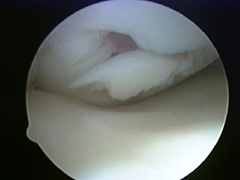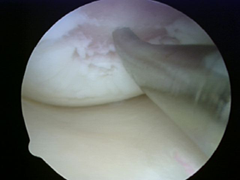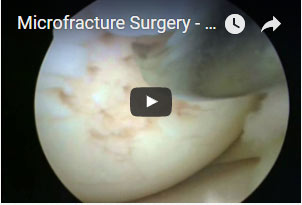
Articular Cartilage Damage
If you are undergoing arthroscopic knee surgery in Houston, your surgeon may also need to perform a microfracture. Microfracture is a surgical technique to treat full thickness defects or loss of the articular surface of a joint, usually the knee joint. The joint surface is very important, and if it is lost or damaged osteoarthritis can set in. Microfracture is a technique used to try to re-grow or re-generate the chondral surface of the joint. (See the photo of damaged joint surface on the right)
In microfracture surgery, nothing is really “fractured” or broken by the treating surgeon, only the surface of the joint is perforated with a surgical tool that places small holes in the bone to try and get the body’s own healing processes to begin to grow a new cover over the surface of the joint coming through the surgically made holes.

Placing small holes in the bone
helps the the bone grow a new surface
Microfracture is 80% successful in producing significant pain relief and improvement in the ability to return to sports, even at the professional level. Fifteen to twenty per cent of patients are not helped by the knee surgery procedure and may go on to need another procedure including some type of joint replacement.
The usual patient I encounter that ends up with a microfracture is one that is having knee surgery for a meniscus tear or ACL tear. At surgery, much worse damage to the joint surface was present than was expected based on the history of injury or the MRI prior to surgery. The microfracture is added to other procedures or may be the only procedure performed if only joint surface damage is found at arthroscopy of the knee.
The symptoms of someone needing a microfracture mimic the symptoms of a meniscus or cartilage tear. These include pain, catching, locking, swelling, giving way and noise (crepitation) upon joint motion.
Microfracture knee surgery is indicated for use when the patient is not too old (over 65), and the damage is not too extensive. The knee should not be bow legged or knock kneed. The patient has to be able to use crutches or a walker and not have a disease like rheumatoid arthritis.
TECHNIQUE: The technique is 100% arthroscopic. The damaged area is cleaned with a shaver and then perforated with a tiny bone awl, with holes being made 3 mm apart. Bone marrow comes out through the holes that are made and a blood clot forms over the surface of the bone, which becomes a matrix for healing articular cartilage to regrow. (See the video on the right)
It usually takes two to six months for the patient to experience substantial pain relief and pain reduction will continue to improve for up to 2 years.
Microfracture Knee Surgery Recovery
POST-OPERATIVE CARE: The key to a good result from a microfracture is staying off the leg for six to eight weeks following the microfracture surgery. This means using crutches or a walker for this time period and no significant weight on the leg or walking on it for this time period. One may balance in the shower. I recommend that a patient start riding a stationary bicycle daily for a half hour beginning one week after surgery with the bike on moderate resistance. A CPM (continuous passive motion machine) is used for 8 hours every 24 hours for 8 weeks. The patient needs to make sure he or she gets the knee completely straight and completely bent each day. Walking begins at 8 weeks and sports involving cutting and jumping are not permitted for 4 to 6 months when it comes to microfracture knee surgery recovery.
If this microfracture knee surgery works, it is better than having a joint replacement. Microfracture is not a cure for osteoarthritis, it is done to try and prevent osteoarthritis from occurring.

 Dr. Larry Likover has been practicing orthopedics on the west side of Houston for 43 years, treating knee, hip, shoulder, and back problems. Dr. Likover is board certified in orthopedic surgery and provides knee replacement in Houston for patients worldwide.
Dr. Larry Likover has been practicing orthopedics on the west side of Houston for 43 years, treating knee, hip, shoulder, and back problems. Dr. Likover is board certified in orthopedic surgery and provides knee replacement in Houston for patients worldwide.